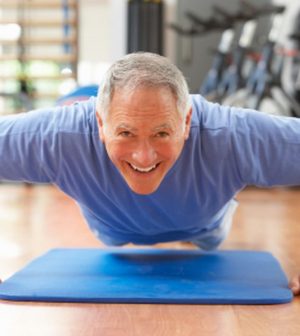- Navigating Your Midlife Crisis: Embracing New Possibilities
- City Raccoons Showing Signs of Domestication
- Mapping the Exposome: Science Broadens Focus to Environmental Disease Triggers
- One Week Less on Social Media Linked to Better Mental Health
- Your Brain Changes in Stages as You Age, Study Finds
- Some Suicide Victims Show No Typical Warning Signs, Study Finds
- ByHeart Formula Faces Lawsuits After Babies Sickened With Botulism
- Switch to Vegan Diet Could Cut Your Greenhouse Gas Emissions in Half
- Regular Bedtime Does Wonders for Blood Pressure
- Dining Alone Could Mean Worse Nutrition for Seniors
Exercising When You Have High Blood Pressure

High blood pressure is a serious risk factor for heart disease, stroke and other life-threatening medical conditions. While many people need medication and dietary changes to control their blood pressure, exercise is a key component of nearly every management plan.
Scientists know that exercise causes the body to adapt in ways that lower blood pressure, but there’s no single formula guaranteed to work for everyone. However, there are general guidelines regarding four key aspects of exercise.
Frequency: Aim to do aerobic exercise on a daily basis and strength training twice a week (on non-consecutive days to allow for muscle repair).
Intensity: Aim for moderate intensity exercise to start. For aerobic workouts, that means reaching between 60% and 70% of your maximum target heart rate (or 220 minus your age). Evidence suggests that higher intensity exercise can result in greater reduction of high blood pressure, but at the moment the risks aren’t clear.
Duration: Aim for at least 30 minutes of aerobic activity a day, increasing to 60 minutes if possible. If time or ability is a problem, work out in 10-minute segments that add up to your daily total. Strength training should target all major muscle groups using weight that enables you to complete two to three sets of 10 to 12 reps each.
Type: Effective aerobic activities that are easy to start with are walking, cycling and swimming. Strength training can be done with free weights, weight machines, stretchy resistance bands and/or your own bodyweight (pushups, for instance).
Working with your doctor on your exercise plan is a must. He or she may suggest testing to determine your ideal target heart rate during vigorous activity. If you’re on high blood pressure medication, you’ll want to make sure that it doesn’t affect your ability to exercise.
More information
The American Heart Association has a complete guide to exercising with hypertension online.
Source: HealthDay
Copyright © 2025 HealthDay. All rights reserved.










